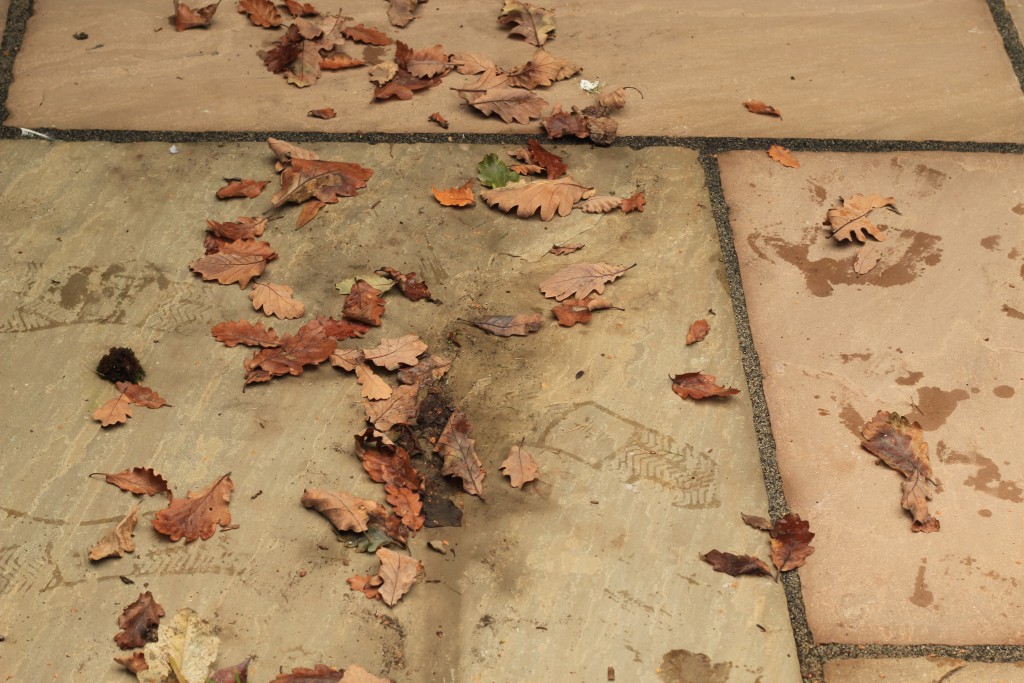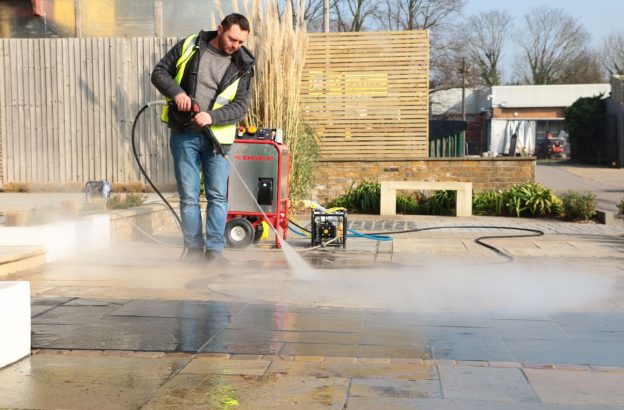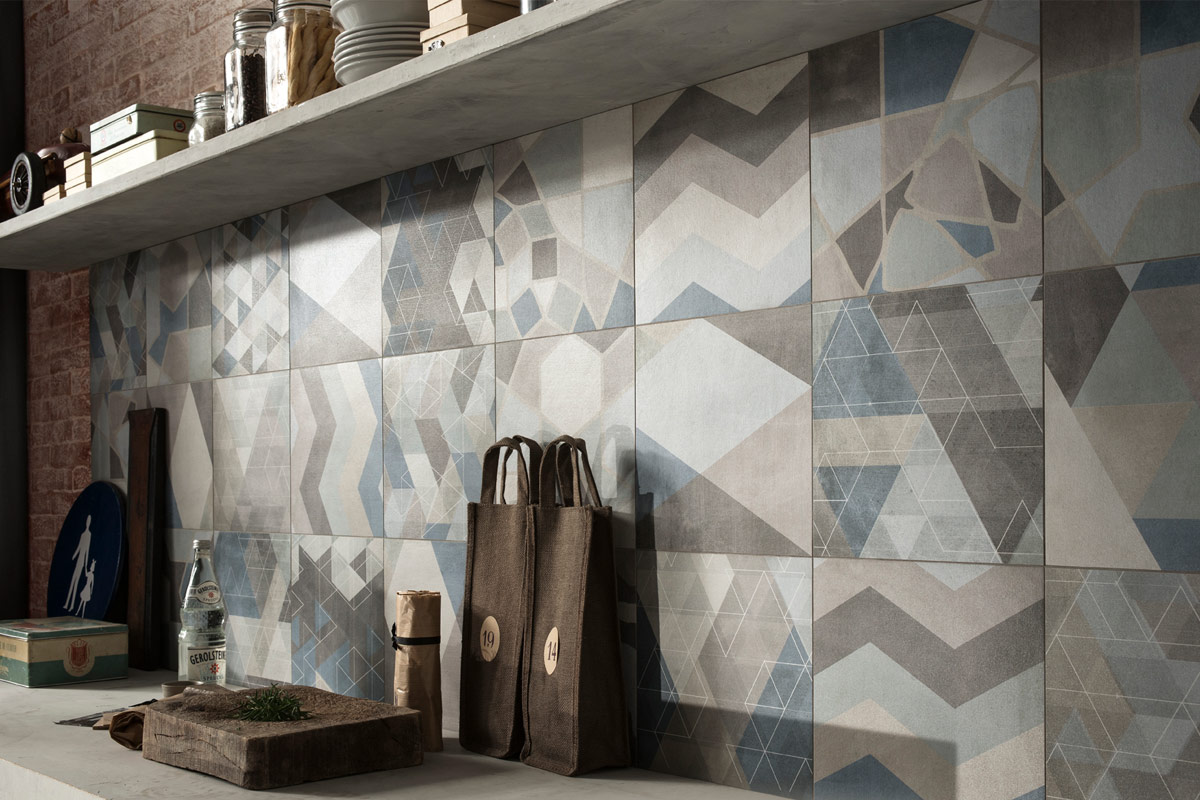Learn best practice for how to clean indoor porcelain tiles to keep them looking their best!
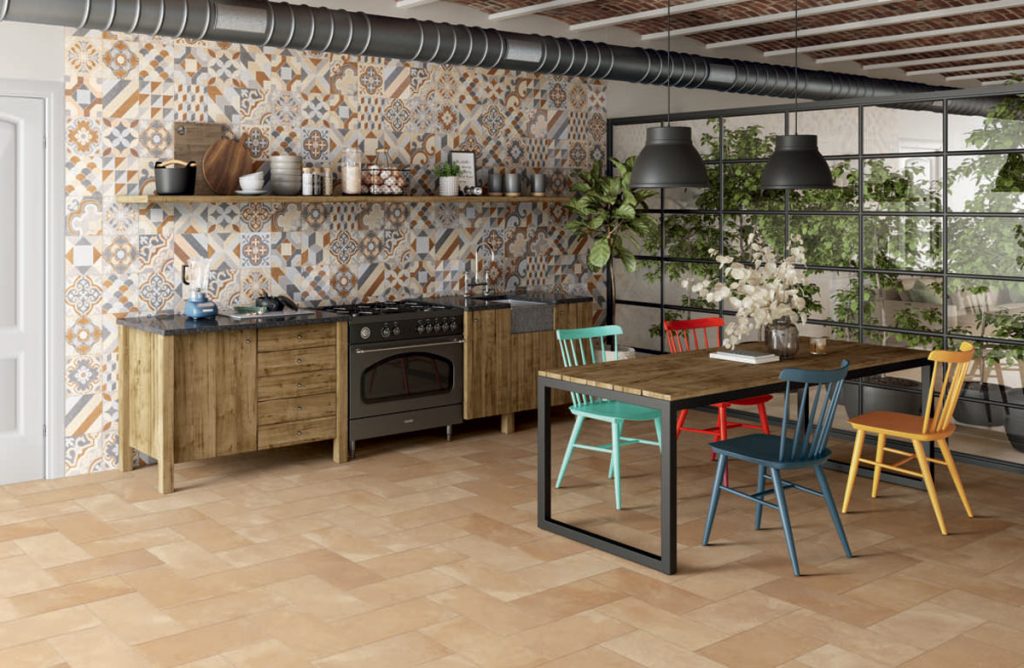
If you've purchased our large-format porcelain tiles, you may be wondering about the best way to clean them. Or perhaps you have an Indoor Outdoor paving design and are wondering if you can clean the tiles in the same way inside the house and on the patio. If the latter is the case, then you can find more information on how to clean porcelain tiles outdoors.
Cleaning internal tiles
We have put together this quick step-by-step guide, along with our top tips, to keep your indoor tiles looking their best, wherever they are in the house. Please note we're advising on porcelain tiles, which are extremely robust and hard-wearing. Some natural stone tiles or patterned tiles may need gentler treatment and equipment.
1. Cleaning the walls
If your tiles are not too dirty, then warm soapy water will do the trick. Just give your tiles a wipe down to remove any stains and debris. For tougher stains, use a tile cleaner suitable for indoor use (such as Lithofin Power Clean) and a good bit of elbow grease to lift everything from the surface of the tile. Once all stains are removed, use warm water and a clean cloth to remove any excess tile cleaner. Lastly, dry the tiles with a clean cloth for a glossy finish.
2. Cleaning the floors
Sweep or vacuum
First things first: remove any excess dust or dirt that has gathered. Use a vacuum or soft brush to remove the dirt. As an alternative to a brush, a dry mop can be a better choice, as this will provide better day-to-day protection for the surface of the tile.
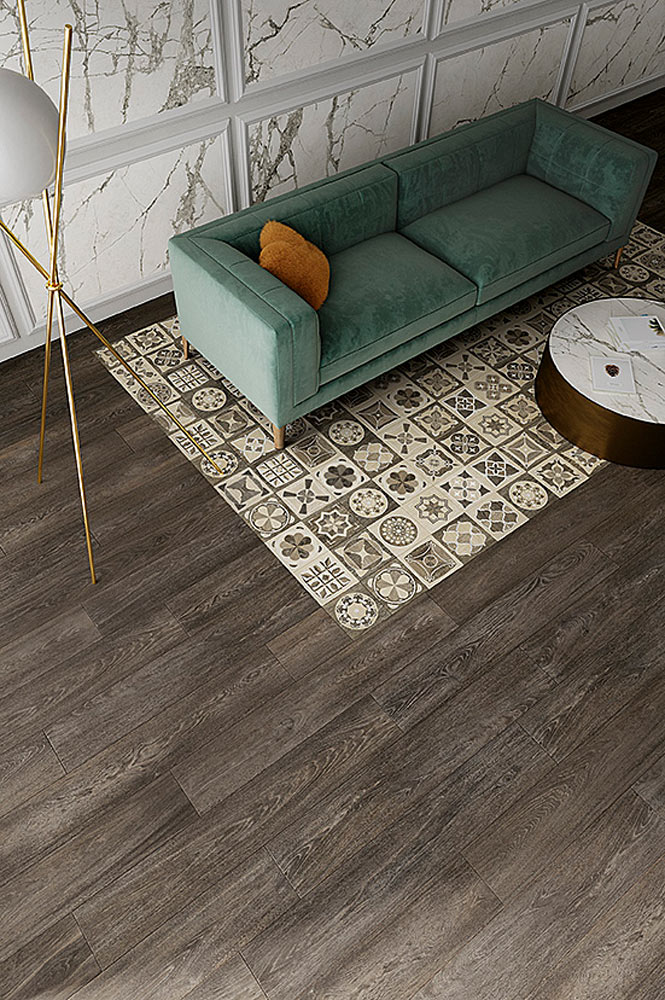
Mop
For everyday cleaning, use warm water and a mop or microfibre cloth. Every few weeks, or when necessary, clean with a mild detergent mixed in warm water.
For regular cleaning, be sure to avoid chemical cleaners that contain ammonia, bleach or acids. You should only consider chemicals to remove any stubborn stains. Using corrosive chemicals regularly can lead to the erosion of the surface of the tiles, whilst also increasing their absorption rate. This would ultimately mean they got dirtier quicker. Chemicals can also erode the grout over time, which can lead to loosening of tiles and allow water to breach the underside of the tiles.
When using a detergent, you should ensure it is of a low concentration. If your tiles are a textured porcelain, they may need a slightly higher concentration.
Wash away detergents
When you are mopping do no not let the cleaning solution dry. Use clean warm water to mop the area and remove any detergent. Repeat this process to remove any detergent residue that may remain on the face of the tile. Thoroughly removing the detergent residue will prevent water spots or powdery marks that can be left behind on the tiles.
Clean the grout
The hardest part of cleaning kitchen tiles is the grout. Grout can discolour over time from dirt and grease, so it is essential that you do not skip this step. Grout is also where you are most likely to find mould in your bathroom. Discoloured grout lets down the entire look, no matter how clean your tiles are. On the upside, cleaning grout has a powerful lifting effect on a room, making it instantly brighter and more welcoming.
There are several methods for cleaning grout. The quickest and easiest method for getting it to sparkle again is to use baking soda, warm water, and a toothbrush.
- Create a paste out of the baking soda and warm water. You can use white vinegar instead of water, if you prefer. Use the toothbrush to apply this paste and scrub the grout.
- Leave the grout with the paste on for about half an hour.
- Rinse it off with warm water and a clean cloth. For areas that require a little more work, repeat this process.
3. Stain removal
Not all stains are created equal, so using the same cleaning method for all stains is not best practice. Clean only the affected area, not the whole floor or wall, and tackle the individual stain in a targeted method to remove it first time.

If your stain is more major, you may need to consider treating it with a more aggressive approach that requires a special tile cleaner tailored to the problem. Such treatment can cause a change in colour of the tile, so should only be used if absolutely necessary.
Find the best method to target the particular stain and be sure to only clean the affected area. Be sure to wear suitable protection like gloves, masks and eye protection, as well as ventilating the area. It’s a good idea to test the product on a small, out-of-the-way area the first time you use it, to ensure it doesn’t affect tile colour.
4. Prevent Stains
Try to mitigate the build-up of stains by wiping them up as soon as possible and washing away any residue. Whilst porcelain tiles are highly resistant, they can still change shade slightly if a mess is left to linger for a longer period of time. It's also advisable from a safety point of view, as liquids such as shampoo and shower gel can make tiles slippery.
Now you know how to clean porcelain tiles properly, you can keep your tiles looking their best for years to come. For tiles in the garden, see our guide on how to clean outdoor porcelain paving.
Post Updated: August 2024


/filters:quality(60)/mediadev/media/menu-pics/all-porcelain.jpg )
/filters:quality(60)/mediadev/media/menu-pics/luxury-italian.jpg )
/filters:quality(60)/mediadev/media/menu-pics/premium-italian.jpg )
/filters:quality(60)/mediadev/media/menu-pics/budget-porcelain.jpg )
/filters:quality(60)/mediadev/media/menu-pics/large-format-porcelain.jpg )
/filters:quality(60)/mediadev/media/menu-pics/wood-effect-porcelain.jpg )
/filters:quality(60)/mediadev/media/menu-pics/porcelain-planks.jpg )
/filters:quality(60)/mediadev/media/menu-pics/porcelain-setts.jpg )
/filters:quality(60)/mediadev/media/menu-pics/browse-all-paving.jpg )
/filters:quality(60)/mediadev/media/menu-pics/stone-paving.jpg )
/filters:quality(60)/mediadev/media/menu-pics/interior-tiles.jpg )
/filters:quality(60)/mediadev/media/menu-pics/stone-effect-porcelain.png )
/filters:quality(60)/mediadev/media/menu-pics/wood-effect-porcelain.png )
/filters:quality(60)/mediadev/media/menu-pics/grey-porcelain.png )
/filters:quality(60)/mediadev/media/menu-pics/beige-porcelain.png )
/filters:quality(60)/mediadev/media/menu-pics/dark-porcelain.png )
/filters:quality(60)/mediadev/media/menu-pics/light-porcelain.png )
/filters:quality(60)/mediadev/media/menu-pics/patio-grout.jpg)
/filters:quality(60)/mediadev/media/menu-pics/primers.jpg)
/filters:quality(60)/mediadev/media/menu-pics/porcelain-blades.jpg)
/filters:quality(90)/mediadev/media/menu-pics/drainage.jpg)
/filters:quality(60)/mediadev/media/menu-pics/cleaners.jpg)
/filters:quality(60)/mediadev/media/menu-pics/all-stone-paving.jpg )
/filters:quality(60)/mediadev/media/menu-pics/all-sawn-paving.jpg )
/filters:quality(60)/mediadev/media/menu-pics/all-riven-paving.jpg )
/filters:quality(60)/mediadev/media/menu-pics/indian-sandstone.jpg )
/filters:quality(60)/mediadev/media/menu-pics/limestone-paving.jpg )
/filters:quality(60)/mediadev/media/menu-pics/granite-paving.jpg )
/filters:quality(60)/mediadev/media/menu-pics/slate-paving.jpg )
/filters:quality(60)/mediadev/media/menu-pics/yorkstone-paving.jpg )
/filters:quality(60)/mediadev/media/menu-pics/stone-pavers.jpg )
/filters:quality(60)/mediadev/media/menu-pics/cobbles-setts.jpg )
/filters:quality(60)/mediadev/media/menu-pics/plank-paving.jpg )
/filters:quality(60)/mediadev/media/menu-pics/paving-circles.jpg )
/filters:quality(60)/mediadev/media/menu-pics/bespoke-paving-1.jpg )
/filters:quality(60)/mediadev/media/menu-pics/edging-stones-1.jpg )
/filters:quality(60)/mediadev/media/menu-pics/prestige-stone.jpg )
/filters:quality(60)/mediadev/media/menu-pics/grey-blue-stone.png)
/filters:quality(60)/mediadev/media/menu-pics/swatch-black-dark.jpg )
/filters:quality(60)/mediadev/media/menu-pics/swatch-buff-beige-white.jpg )
/filters:quality(60)/mediadev/media/menu-pics/sealants.jpg)
/filters:quality(60)/mediadev/media/menu-pics/all-clay-paving.jpg )
/filters:quality(60)/mediadev/media/menu-pics/alpha-clay-pavers.jpg )
/filters:quality(60)/mediadev/media/menu-pics/cottage-garden-clay-pavers.jpg )
/filters:quality(60)/mediadev/media/menu-pics/kessel-garden-clay-pavers.jpg )
/filters:quality(60)/mediadev/media/menu-pics/artisan-clay-pavers.jpg )
/filters:quality(60)/mediadev/media/menu-pics/grey-blue-clay-paver.png )
/filters:quality(60)/mediadev/media/menu-pics/red-brown-clay-pavers.png )
/filters:quality(60)/mediadev/media/menu-pics/beige-buff-clay-pavers.png )
/filters:quality(60)/mediadev/media/menu-pics/composite-decking.jpg )
/filters:quality(60)/mediadev/media/menu-pics/designboard-decking.jpg )
/filters:quality(60)/mediadev/media/menu-pics/classic-designboard.jpg )
/filters:quality(60)/mediadev/media/menu-pics/brushed-designboard.jpg )
/filters:quality(60)/mediadev/media/menu-pics/grooved-designboard.jpg )
/filters:quality(60)/mediadev/media/menu-pics/millboard-decking.jpg )
/filters:quality(60)/mediadev/media/menu-pics/grey-decking.jpg )
/filters:quality(60)/mediadev/media/menu-pics/black-charcoal-decking.jpg)
/filters:quality(60)/mediadev/media/menu-pics/brown-decking.jpg)
/filters:quality(60)/mediadev/media/menu-pics/all-build-deck.png )
/filters:quality(60)/mediadev/media/menu-pics/stone-cladding.jpg )
/filters:quality(60)/mediadev/media/menu-pics/all-garden-walling-1.jpg )
/filters:quality(60)/mediadev/media/menu-pics/facing-bricks.jpg )
/filters:quality(60)/mediadev/media/menu-pics/garden-screening.jpg )
/filters:quality(60)/mediadev/media/menu-pics/all-steps-coping.jpg )
/filters:quality(60)/mediadev/media/menu-pics/stone-garden-steps.jpg )
/filters:quality(60)/mediadev/media/menu-pics/sawn-steps.jpg )
/filters:quality(60)/mediadev/media/menu-pics/riven-steps.jpg )
/filters:quality(60)/mediadev/media/menu-pics/yorkstone-steps.jpg )
/filters:quality(60)/mediadev/media/menu-pics/bespoke-steps.jpg )
/filters:quality(60)/mediadev/media/menu-pics/porcelain-steps.jpg )
/filters:quality(60)/mediadev/media/menu-pics/off-the-shelf.jpg )
/filters:quality(60)/mediadev/media/menu-pics/stone-coping.jpg )
/filters:quality(60)/mediadev/media/menu-pics/sawn-coping.jpg )
/filters:quality(60)/mediadev/media/menu-pics/riven-coping.jpg )
/filters:quality(60)/mediadev/media/menu-pics/yorkstone-coping.jpg )
/filters:quality(60)/mediadev/media/menu-pics/bespoke-coping.jpg )
/filters:quality(60)/mediadev/media/menu-pics/stone-pier-caps.jpg )
/filters:quality(60)/mediadev/media/menu-pics/porcelain-coping.jpg )
/filters:quality(60)/mediadev/media/menu-pics/all-bespoke-services.jpg )
/filters:quality(60)/mediadev/media/menu-pics/bespoke-paving-2.jpg )
/filters:quality(60)/mediadev/media/menu-pics/bespoke-steps-1.jpg )
/filters:quality(60)/mediadev/media/menu-pics/bespoke-coping-1.jpg )
/filters:quality(60)/mediadev/media/menu-pics/edge-profiles.jpg )
/filters:quality(60)/mediadev/media/menu-pics/masonry-services.jpg )
/filters:quality(60)/mediadev/media/menu-pics/deluxe-pergolas.jpg )
/filters:quality(60)/mediadev/media/menu-pics/proteus-pergolas.jpg )


